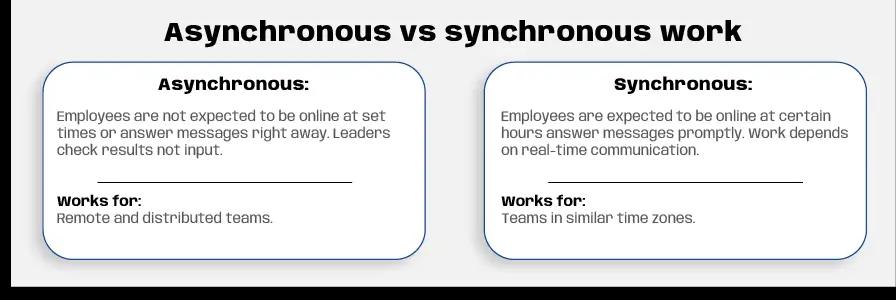The post-pandemic reality is already here. Some companies have stuck with a fully remote model and increased cooperations with external service providers, while others offer going back to offices completely or at least partially. But most importantly, all of them are now adjusting schedules to not merely cover current business needs but to anticipate future needs and fuel corporate growth. Consequently, the need to match hybrid work schedules and empower all teams to work together effectively is becoming increasingly urgent.
The concept “asynchronous work” has emerged as one of the solutions to this problem. People believe that such an approach contributes to a healthy work-life balance and boosts daily productivity. You may be wondering why it is important. These days people admit that when they have a chance to work flexibly, 87 percent of them do. This number once again proves that remote work is highly appreciated and may turn out to be a deal breaker when not offered to new hires. Moreover, as more people seek remote work opportunities, asynchronous work has become a reality for more than just digital nomads.
But what is asynchronous work, and what does it look like in an organization? What is a hybrid work schedule, and will it really improve productivity in your company? Let’s find out together.
The difference between asynchronous and synchronous work
Asynchronous work happens when different people on the same team work in different time zones, meaning that each member operates within their own schedule. Some may have to check in with their managers periodically, and others may be free to maintain their schedule and choose not to attend a meeting and view the recording later. Although team members don’t share the same physical or online space simultaneously, they share objectives, clarity, and communication. The principal asset comes from leadership, since they monitor results, not input. The same happens with hybrid work, meaning employees can choose or have set days for working from the office, mixing remote and in-person interactions.
The main difference with synchronous work lies in real-time communication since the number of hours employees should be online or responsive is crucial for others to execute their tasks. Meanwhile, asynchronous work allows people to manage communication separately from work. This becomes possible when employees know their duties well and don’t depend on constant live contact with other team members.
At this point, you may wonder what the most common cases are when asynchronous work is needed and if this work style fits your organization. It’s not for everyone, but the growing talent shortage is forcing enterprises to consider various options. Consequently, more processes are being adjusted to meet the expectations of staff. Companies must prepare to embrace an asynchronous work culture sooner than later and understand the right process and roles that can fit this work style.
Influence of asynchronous work on day-to-day operations
When asynchronous work is well-organized, it may help improve different business areas, especially when it comes to basic daily activities. The following aspects reflect the potential asynchronous work meaning for your team:
1. Communication and transparency
A major influence of the async approach is reflected in the vital role that communication and transparency play in daily tasks. When employees have clearly defined expectations and all the necessary information to execute their jobs, they don’t need to wait for someone to reply to their questions. People should have access to all the data needed at all times. In this case, there would be no need for extra conversations since all the information has already been provided.
2. Productivity
Since the async working model ensures fewer interruptions and bottlenecks, team members get a chance to work at their peak productive hours. Such an approach allows more focus time and faster completion of tasks under less pressure. Meanwhile, employees take full control of their jobs and have the initiative to deliver effective results. When this happens, productivity is highly impacted and improved.
3. Deadline and guidelines
A hybrid work schedule must come with comprehensive guidelines and clear deadlines. This approach helps everyone in the team to be on the same page when it comes to prioritizing and getting tasks done. When everyone involved in the project knows the timeline, they can plan and schedule their workload to meet it. Meanwhile, if managers check employees’ availability before assigning tasks, deadlines will be more realistic, and the scope will be better distributed. By doing so, you’ll set asynchronous teams on a clear path to success.
4. Teamwork
Asynchronous teams either have a fully remote or hybrid work schedule. Such an approach offers each member flexibility and ownership of their tasks and schedules. Additionally, employees can choose when to work and focus on their main priorities. An async working model eliminates a common bidding of being online at concrete hours, so it reduces stress and helps team members understand each other and work better. When people can create their own boundaries between work and personal life without feeling judged, their results and commitment increase.
Benefits of having a hybrid work schedule for remote teams
Remote and hybrid working models aren’t going away anytime soon. So, companies should accept that fact, adjust, and take advantage of flexible work schedule benefits. As work culture keeps evolving, it is time for leaders to examine the potential of their companies along with the ever-changing circumstances and staff expectations. So, let’s see what advantages you should expect after employing this new approach to team management and how all that can improve your operations.
- Access to global talent pools. Asynchronous work allows companies to hire people anywhere without geographical or time zone limitations, thus increasing recruiting capabilities. HR managers can access unique skills and knowledge and bring in the brightest minds to their organizations. As a result, they can add diversity and inclusion to their work culture.
- Employee independence. Introduce a demo meeting between the developer and the test engineer as a required step before passing the newly implemented feature into testing. 52 percent of employers say their staff productivity has increased since going remote. Promoting self-reliance at work has also impacted how employees feel about their jobs. Recently, 85 percent of people stated that they are satisfied with their productivity working from home, and 76 percent think that most processes are transparent and well-documented.
- Team productivity. Since each employee becomes more productive by gaining independence and taking ownership of their tasks, the whole team learns not to wait for updates to complete their work. Team meetings become more effective, as they now focus on the discussion of priorities and working approaches. Consequently, async teams are able to move faster through the project cycle.

Final thoughts
If your company is already trying to implement an async working model effectively, it’s essential to consider time zones, planning, and intentional communication. As more teams adopt a hybrid work schedule and embrace the asynchronous style, leaders need to pay attention to their pings and urgent communication, especially to avoid creating anxiety by messaging people too much. Like any change, it takes time to adapt, but if you do your best to empathize with your team and learn how they work, you and the entire business will thrive.







